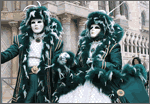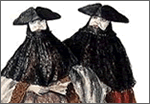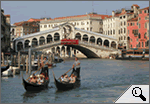|
|
|
 |
 |
 > The Carnival of Venice: Past and Present > Masks and costumes > The City of Canals dijous, 24 de gener de 2008
Carnival, the most extravagant festival of the year (known here as 'Carnestoltes') is drawing near. Lasting one week, from Shrove Thursday to Ash Wednesday, this year it will take place from the 31st of January to 6th of February. Musical groups and dances, masks and costumes will be the protagonists of this period of frenzied entertainment which gives reason to the saying 'In Carnival, anything goes'.
Carnival has pagan roots and its origins lie in old festivals such as the Roman Saturnalia (characterised by the undermining of everyday rules), and more generally, in the celebrations of the arrival of spring. In the Christian tradition, the festival precedes Lent, a period of 40 days of fasting and penance which comes to an end at Easter. Carnival has remained strong despite the prohibitions it has undergone, and today it is celebrated by many in different parts of the world. In the Catalan Countries it is celebrated in Sitges, Vilanova i la Geltrú (Garraf), Vinaròs (Baix Maestrat), Solsona (Solsònes), etc. Particularly spectacular and worldwide famous are the carnivals of Rio de Janeiro, Bahia, New Orleans, Cadiz, Santa Cruz de Tenerife and Venice, which will start tomorrow and continue until 5th February.
The Carnival of Venice: Past and Present
+ The carnivalesque spirit of former times was revived twenty years ago.
The Carnival of Venice, of long-standing tradition, is the most renowned carnival in Europe. In the past, the festival lasted for a few months, and the public celebrations were complemented by private parties in nobility palaces, with sumptuous balls embellished with games of all sorts. The carnivalesque spirit of former times was revived twenty years ago, and today the carnival of Venice is a mixture of rebellion, art and culture that attracts people from all over the world. The entertainment takes place in the city squares, particularly in St. Mark's square, where two great monuments stand: St. Mark's Basilica and the Ducal Palace.
Masks and costumes
+ The Bauta is the most typical mask.
Costumes of all sorts can be seen at the carnival of Venice; from 18th century period clothing to innovative designs. The masks are very characteristic and they are made by specialised manufacturers of recognised status dating back to 1436. The most typical mask is the Bauta, worn by both men and women, consisting of a black cape, a three-cornered hat and a white mask which covers the whole face.
The City of CanalsVenice (Veneto, Italia), a unique city of incomparable beauty and of long-standing commercial, cultural and artistic traditions, is located along the shore of the Adriatic Sea. It is situated on an archipelago made up of one hundred and twenty islands separated by canals and joined by bridges, the most famous of which is the Rialto Bridge. The Rialto Bridge is the oldest of three bridges which cross the nearly four kilometre long, s-shaped Grand Canal which comes to an end at St. Mark's Square, the heart of the city. The magnificent palaces and the famous gondolas (the traditional boats) finish off the picture.
|
Investiga

> El carnaval de Venècia de l'any passat: fotos.

> Cop d'ull a la tradició veneciana de les màscares .

> El galant Giacomo Casanova, símbol de la Venècia llibertina del segle XVIII.

> Panoràmiques de la 'ciutat dels canals'.
I també...
- Diccionari carnavalesc de Venècia.
- 'Frittelle' i 'Galani', els dolços tradicionals del carnaval venecià.
- Imatge per satèl·lit de Venècia.
- Sobre el rei Carnestoltes i la vella Quaresma.
- Curiositats del Carnaval.
- Carnaval de Tarragona: del 26 de gener al 5 de febrer.
Portada |
Europa Press |
El Punt |
La premsa |
Especials |
Diari de l'escola |
LesFinances.info |
Editorials |
Mail obert |
Els blocs |
Lletres
Tecnologia i ciència | Solidaritat | Cap de 7mana | Campus | El 9 | Presència | Fòrums | Enquestes | Xat | Correu
Traductor | Edicions en Pdf | Wap-pda | Biblioteca | Lletra més grossa
Tecnologia i ciència | Solidaritat | Cap de 7mana | Campus | El 9 | Presència | Fòrums | Enquestes | Xat | Correu
Traductor | Edicions en Pdf | Wap-pda | Biblioteca | Lletra més grossa
| Què és VilaWeb? Publicitat Mapa web Contacte | Una web de Partal, Maresma i Associats, S.L. |


